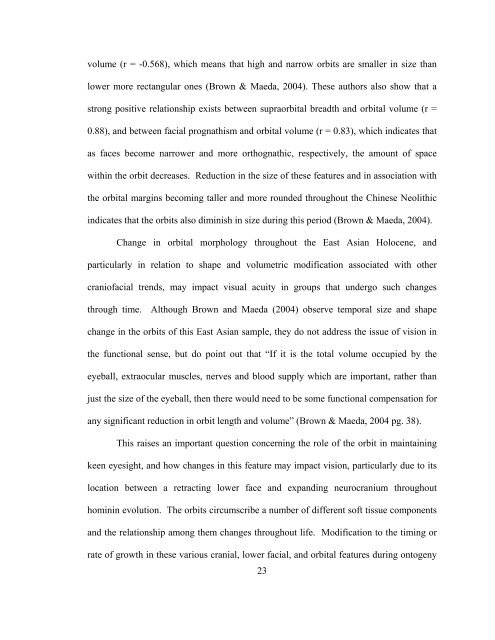modern variation and evolutionary change in the hominin eye orbit
modern variation and evolutionary change in the hominin eye orbit
modern variation and evolutionary change in the hominin eye orbit
You also want an ePaper? Increase the reach of your titles
YUMPU automatically turns print PDFs into web optimized ePapers that Google loves.
volume (r = -0.568), which means that high <strong>and</strong> narrow <strong>orbit</strong>s are smaller <strong>in</strong> size thanlower more rectangular ones (Brown & Maeda, 2004). These authors also show that astrong positive relationship exists between supra<strong>orbit</strong>al breadth <strong>and</strong> <strong>orbit</strong>al volume (r =0.88), <strong>and</strong> between facial prognathism <strong>and</strong> <strong>orbit</strong>al volume (r = 0.83), which <strong>in</strong>dicates thatas faces become narrower <strong>and</strong> more orthognathic, respectively, <strong>the</strong> amount of spacewith<strong>in</strong> <strong>the</strong> <strong>orbit</strong> decreases. Reduction <strong>in</strong> <strong>the</strong> size of <strong>the</strong>se features <strong>and</strong> <strong>in</strong> association with<strong>the</strong> <strong>orbit</strong>al marg<strong>in</strong>s becom<strong>in</strong>g taller <strong>and</strong> more rounded throughout <strong>the</strong> Ch<strong>in</strong>ese Neolithic<strong>in</strong>dicates that <strong>the</strong> <strong>orbit</strong>s also dim<strong>in</strong>ish <strong>in</strong> size dur<strong>in</strong>g this period (Brown & Maeda, 2004).Change <strong>in</strong> <strong>orbit</strong>al morphology throughout <strong>the</strong> East Asian Holocene, <strong>and</strong>particularly <strong>in</strong> relation to shape <strong>and</strong> volumetric modification associated with o<strong>the</strong>rcraniofacial trends, may impact visual acuity <strong>in</strong> groups that undergo such <strong>change</strong>sthrough time. Although Brown <strong>and</strong> Maeda (2004) observe temporal size <strong>and</strong> shape<strong>change</strong> <strong>in</strong> <strong>the</strong> <strong>orbit</strong>s of this East Asian sample, <strong>the</strong>y do not address <strong>the</strong> issue of vision <strong>in</strong><strong>the</strong> functional sense, but do po<strong>in</strong>t out that “If it is <strong>the</strong> total volume occupied by <strong>the</strong><strong>eye</strong>ball, extraocular muscles, nerves <strong>and</strong> blood supply which are important, ra<strong>the</strong>r thanjust <strong>the</strong> size of <strong>the</strong> <strong>eye</strong>ball, <strong>the</strong>n <strong>the</strong>re would need to be some functional compensation forany significant reduction <strong>in</strong> <strong>orbit</strong> length <strong>and</strong> volume” (Brown & Maeda, 2004 pg. 38).This raises an important question concern<strong>in</strong>g <strong>the</strong> role of <strong>the</strong> <strong>orbit</strong> <strong>in</strong> ma<strong>in</strong>ta<strong>in</strong><strong>in</strong>gkeen <strong>eye</strong>sight, <strong>and</strong> how <strong>change</strong>s <strong>in</strong> this feature may impact vision, particularly due to itslocation between a retract<strong>in</strong>g lower face <strong>and</strong> exp<strong>and</strong><strong>in</strong>g neurocranium throughouthom<strong>in</strong><strong>in</strong> evolution. The <strong>orbit</strong>s circumscribe a number of different soft tissue components<strong>and</strong> <strong>the</strong> relationship among <strong>the</strong>m <strong>change</strong>s throughout life. Modification to <strong>the</strong> tim<strong>in</strong>g orrate of growth <strong>in</strong> <strong>the</strong>se various cranial, lower facial, <strong>and</strong> <strong>orbit</strong>al features dur<strong>in</strong>g ontogeny23
















